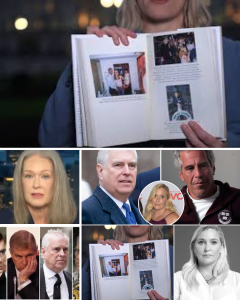A cryptic note in Virginia Giuffre’s lost manuscript stunned investigators: “The palace walls hide more than they protect.” Unearthed after her death, the explosive tell-all reveals coded messages and secret meetings tying Prince Andrew to Jeffrey Epstein’s sinister network. With precise dates and locations, Giuffre’s words expose a web of royal intrigue and alleged payoffs to keep her silent. Buckingham Palace is in turmoil as her revelations name powerful players still in the shadows. Each page burns with her resolve to unveil the truth, no matter the cost. What did she know that threatens the monarchy’s foundation? And why was her manuscript nearly lost forever? The answers are sparking a global uproar.

A single handwritten line has shaken the foundations of Buckingham Palace: “The palace walls hide more than they protect.” Found buried within Virginia Giuffre’s long-lost manuscript, the cryptic message has become a symbol of defiance — and the spark for a royal crisis unlike any other.
Discovered months after her death, Giuffre’s secret memoir is now at the center of an international storm. Sources close to the investigation describe it as a “meticulously detailed exposé,” mapping a dark intersection of power, privilege, and exploitation. Its pages reportedly contain coded messages, private correspondence, and meeting records that tie Prince Andrew to Jeffrey Epstein’s shadowy network — evidence that some say could rewrite modern royal history.
What makes this discovery so explosive is the precision of Giuffre’s account. Each chapter lists dates, flight paths, and locations where alleged encounters and secret meetings took place — from luxury estates in London and New York to hidden retreats in the Caribbean. “She wrote like someone preparing for the truth to be buried,” one investigator revealed. “Every name, every time, every detail — she wanted it preserved.”
The manuscript’s contents suggest not only personal betrayal but systemic collusion. Giuffre allegedly describes “silent settlements” and “royal intermediaries” who worked to suppress her story. One passage, said to have been written just weeks before her passing, reads: “They offered money to erase me, but the truth leaves its own fingerprints.”
Inside Buckingham Palace, the fallout has been immediate. Senior aides are reportedly in crisis meetings as lawyers and PR teams scramble to manage what some are calling “the most serious reputational threat to the monarchy in decades.” An anonymous insider admitted, “If even half of what’s written is authenticated, this could change everything.”
Meanwhile, public outrage is surging. Activists, journalists, and legal experts are demanding that the manuscript be released in full, calling it a vital piece of evidence in understanding the true scope of Epstein’s global web of influence. Online, the phrase #ThePalaceWalls has gone viral, becoming a rallying cry for truth and accountability.
Giuffre’s defiant tone throughout the manuscript is unmistakable. Far from a victim’s lament, her words read as a final stand against the forces that sought to silence her. “They called me a liar,” she writes. “But liars don’t leave maps — and this is my map.”
The mystery deepens with one pressing question: why was this manuscript hidden? Some suspect deliberate suppression; others believe Giuffre feared for her safety and locked it away herself. Whatever the reason, the world now has a glimpse of the truth she fought to preserve.
Her warning — “The palace walls hide more than they protect” — now echoes beyond the page. It is a challenge, a revelation, and a reckoning all at once. And as her lost words ignite a global uproar, one thing is undeniable: the walls are trembling, and the truth is breaking through the cracks.
Leave a Reply